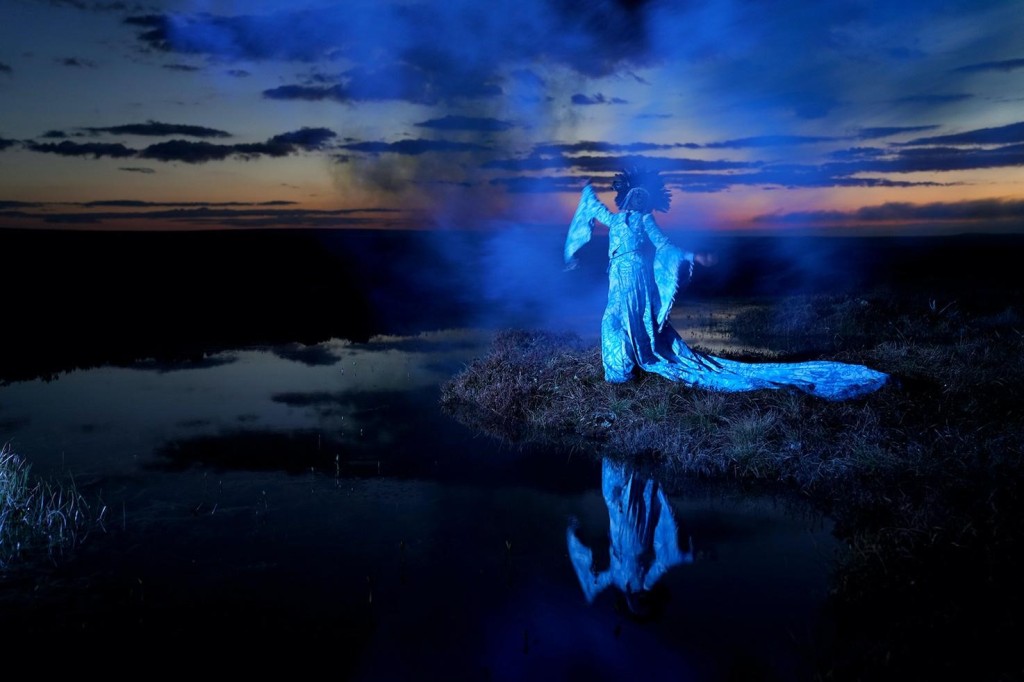As part of our Youth Engagement Action Plan we asked individuals from underrepresented communities to write about nature projects they’re passionate about. Sekai Machache is a Zimbabwean-Scottish visual artist and curator based in Glasgow. Their work looks at the notion of self, using photography to explore the historical and cultural imagination. A fascination with climate change and Scotland’s peatlands has led to a striking set of artworks called The Divine Sky.
In the years leading up to the pandemic, I stumbled into my blue phase with a particular interest in indigo. The legacy of indigo as a colour; a dye and a commodity of vast influence in many cultures across the world was the start of what was to become an immersive, dynamic project titled The Divine Sky.

The Divine Sky utilises allegory and performance to tell a complicated history through creative process, immersive storytelling and photography. This work denotes a process of inscribing and re-inscribing thought through automatic drawing with ink on paper, indigo pigment on fabric which you can see in the images, performance to camera, layering and overlaying.

All the titles of the project are taken from the 12 stages in the indigo dyeing process: Blue of Nothingness, A Hint of Blue, Milky Blue, Lively Blue, Azure Blue, Blue of the Horizon, Ultramarine, Assertive Blue, The Divine Sky, Light Divine Sky, Deep Divine Sky, Profound Divine Sky.
For some time I had been considering what can be collectively done to tackle climate change. Thinking about reforestation, I began to consider habitats with different needs that don’t require trees. This developed into aesthetic considerations of representing a still water source; pools that could reflect the image of the sky. I spoke to a close friend about these concepts and images and she suggested I look into peatlands. My friend sent me images of the bogs near her home in Helmsdale and I got even more inspired. The film titled Profound Divine Sky was shot in the Flow Country in the Scottish Highlands.

The Flow Country is the largest blanket bog in Europe, located across Caithness and Sutherland in Northern Scotland. This complex system of peatland and wetlands is home to diverse wildlife; including red deer and golden eagles. An important feature of the Flow Country is its ecosystem and plethora of sphagnum moss and other plant life, which acts as a contributor in reducing climate change through its impressive ability to store carbon that would otherwise be released in the atmosphere as a greenhouse gas. This is due to the preserving nature of bogs and peatlands, as all plants release their stored carbon dioxide when they die and decay, however peatlands don’t decay as long as they are thriving and healthy. This has allowed the Flow Country to store about 400 million tonnes of carbon alone, making its preservation of the utmost importance.

Before moving to open landscape, The Divine Sky had been confined within my home studio during the height of the Covid-19 restrictions. Thematically the work drew inspiration from a myriad of concepts including African metaphysics, ancestry, Black Scottish identity, and the legacies of colonialism. Using indigo pigment (the West African ancient dying process of which the project is named after) I created automatic drawings using indigo ink on paper and fabric. The process was fluid, measured and meditative. These drawings on fabric would eventually form the dress Blue of the Horizon, made in collaboration with the seamstress Fiona Catherine Powell.

I wanted to break away from traditional Scottish photography, not just with the positioning of a Black subject in the landscape, but also to conjure a long-erased memory that lingers within these spaces. While I address this erasure in the spoken poetry over the film, namely the poem titled Erasure, my physical role in the film is preoccupied with carrying out a series of rituals that are performed through repetitive gestures and in a particular sequence. The fluidity of my movements, informed by the structure of the dress.

These gestures explore the importance of Black bodies reclaiming rural landscapes, ritual practices, and healing modalities from a pre-colonial perspective, through a non-linear narrative that speaks of inherited past, chaotic present and the potential of healing. The score features a varied composition of ambient nature sounds, structured around four original poems recited by myself.
This blog was written by Sekai Machache as part of NatureScot’s Youth Engagement Action Plan. Read more about the role of Scotland’s peatlands in tackling climate change, and explore more of Sekai Machache’s art. The Scottish Biodiversity Strategy delivery plan is due this summer.

You must be logged in to post a comment.